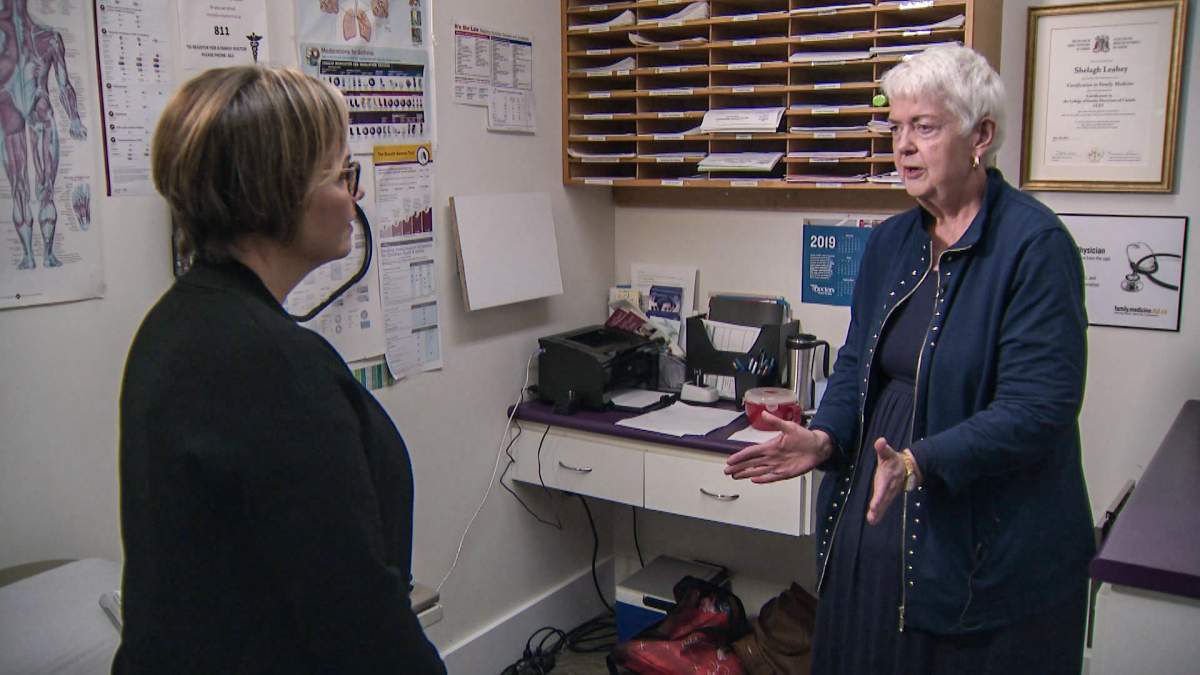You’d think after 43 years as a family doctor in Nova Scotia — many of them spent working 80 hours a week — Dr. Shelagh Leahey has done her time healing the sick and injured.

But every time she attempts to retire, she fails.
“I actually have retired three times, officially,” Leahey says. “But it didn’t hold.”
She jokes that’s because she’s a sucker. The real reason is because she is dedicated to patient care and doesn’t want to leave anyone in the lurch.
“I can’t say no to people who have conditions like cancer or diabetes or who have had a stroke and need follow up care that cannot be provided in an emergency room,” she says.
There’s a paradox about doctors in Canada. On the one hand, the supply has never been better. According to the Canadian Institute for Health Information, there were almost 90,000 doctors practising in Canada in 2018 — that’s up by 3.8 per cent from 2017.
It means Canada has more doctors per capita than ever before. Yet according to the latest figures available from Statistics Canada, 4.7 million Canadians reported they don’t have a primary health-care provider. And the shortage is especially acute in small towns and rural areas.
“There is a huge need for people to take care of patients,” Leahey tells me from her tiny clinic in Yarmouth, N.S. It was built by volunteers from the community using materials paid for by a fundraising campaign — a measure of how badly it was wanted, and how badly it is needed.
“I’ve downsized every time I’ve retired and gone to a smaller practice. And now I’m on my smallest practice which is two days a week with 300 full time patients.”

She did it as a stop-gap measure to help what she calls “orphan patients” — people whose family doctor has retired or moved away. But demand has soared. She now has a waiting list that is six months long. And people are coming from communities many kilometres away.

Get weekly health news
“I get patients from Digby and Shelburne and Barrington. I mean, it’s not just this community. It’s the whole western end of Nova Scotia,” she says.
And it’s a story repeated across the country, especially in rural areas and smaller cities and towns.
What do the “orphan patients” tell her?
“They tell me they’d go to the emergency room to get their pills renewed and nobody’s done any tests and they haven’t had a full checkup, or they have nobody who will follow them,” she says.
That wealth of doctors Canada now has mostly flock to urban areas. Even there, many are choosing to take jobs in hospitals or work as specialists, rather than take on the intense workload of a family practice, along with the burden of paying for overhead and staff.
“They’re not working 80 hours a week, which is what I did every day of the week for 48 weeks of the year,” Leahey says. “I delivered all the babies in my practice. I assisted at all the operations. I worked in the emergency room. I did house calls. And did palliative care. ”
Young doctors today, she says, want a better work-life balance.

Leahey retired from family practice for the first time in 2006 to do palliative care and help bring internationally trained doctors to Nova Scotia. Then she started up a small practice again, partly with the aim to help get herself replaced.
She used it to help train family doctors in the local area. But when she wanted to leave that behind, there still was no one willing to take on her patients.
“I want to help as much as I can,” Leahey says. “But at age 68, you can’t work full time all the time. It would be great if somebody would come up with a plan, whether it’s the federal government or the provincial to help physicians ease out of practice financially.”
She says the fact she now has a wait list of six months is insane.
“I did all I could with the international medical grads and mentoring residents and all that stuff. Now I just do what I can personally,” she says. “A little bit is better than nothing.”

I ask her if it’s possible her patients might not have a place to go when she finally does retire for good.
“That is correct,” she tells me. “And that is very sad.”
Editor’s note: This post has been updated to correct the name of Dr. Shelagh Leahey.








Comments